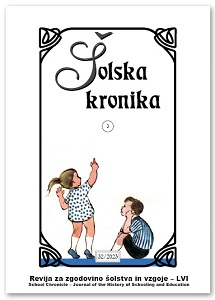Vloga kulturne identitete gluhih in naglušnih mladostnikov v procesu vzgoje in izobraževanja
The role of cultural identity of deaf and hard of hearing adolescents in the educational process
Author(s): Damjana Kogovšek, Jerneja Novšak BrceSubject(s): Education, Sociology of Culture, Inclusive Education / Inclusion, Sociology of Education, Identity of Collectives, Pedagogy
Published by: Slovenski šolski muzej
Keywords: deaf/Deaf adolescents; hard-of-hearing adolescents; Deaf cultural identity;
Summary/Abstract: The development of cultural identity among the deaf is a complex and difficult process that has been studied by many researchers, especially in the last century. They have found that the development of Deaf identity is influenced by many different factors, which they have then demonstrated in their studies using qualitative or quantitative research methods, such as the degree of hearing loss, inclusion in educational institutions, the form of schooling and the environment in which the deaf grow up, the way in which they communicate, etc. All these factors influence and interact with each other. Deaf and hard of hearing people, among whom deaf and hard of hearing adolescents are a large group, are a very heterogeneous group with different audiological as well as demographic characteristics. It is important to note that deaf and hard of hearing adolescents use a variety of communication methods, from spoken language, where they can be assisted by hearing aids, to sign language. All of this has an impact on the development of their cultural identity. Deaf adolescents, whose preferred mode of communication is Sign language, can be considered as a linguistic minority with their own language and behaviour. Many studies have shown that deaf adolescents who use sign language as their main mode of communication consider themselves as a linguistic and cultural minority rather than as persons with disabilities or hearing loss. The concept of Deaf identity is very important for Deaf people, as it emphasises the Deaf community with its distinctive ways and has led to the development of a Deaf cultural and linguistic identity. In this paper we present analyses of the theory of deaf identity development and highlight the importance of some factors that have a significant impact on the identity development of deaf adolescents who face multiple challenges during their growing up phase. We highlight and elaborate on a model of deaf identity development that describes the process in which some audiologically deaf persons acquire a cultural deaf identity. The presented model assumes four types of cultural identities, hearing, marginal, immersive and bicultural identities. Adolescents with a bicultural identity feel comfortable with both deaf and hearing individuals. They belong to the Deaf community, but they also value and feel comfortable with hearing people. Identity formation is a process that begins early in life and continues into adulthood. Professionals working in the field of deafness need to be aware that there are many factors that influence the formation of deaf identity in deaf and hard of hearing adolescents throughout their development.
Journal: Šolska kronika: revija za zgodovino šolstva in vzgoje
- Issue Year: 32/2023
- Issue No: 3
- Page Range: 312-327
- Page Count: 16
- Language: Slovenian

